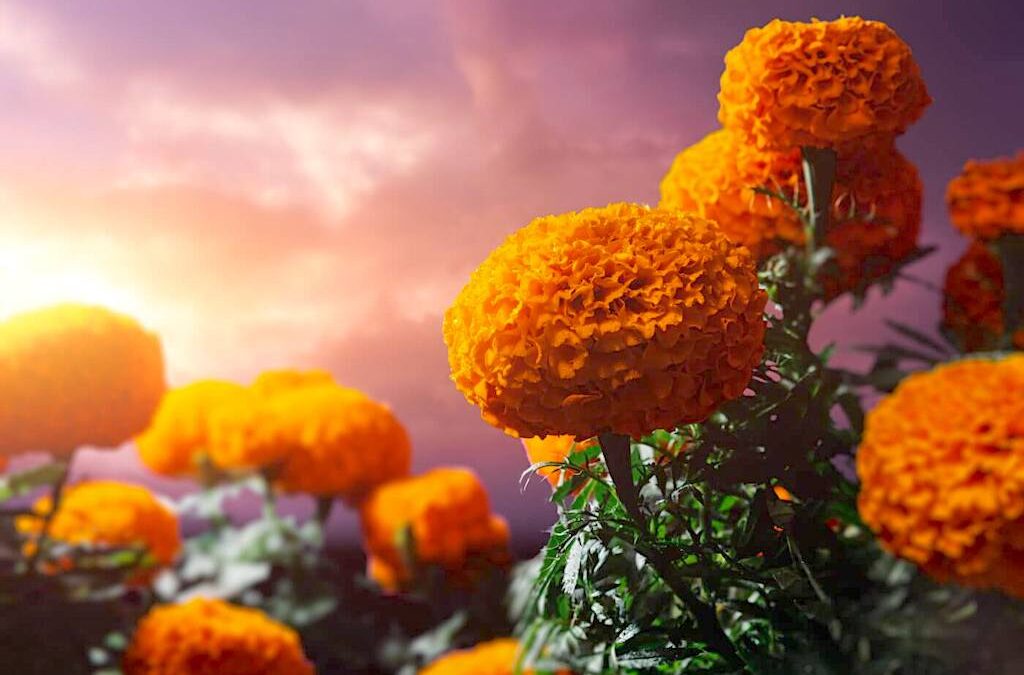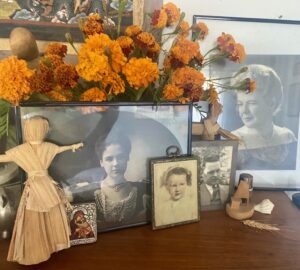“With my eyes turned to the past, I walk backwards into the future.” ―Yohji Yamamoto
All Hallows Blessings!
Many cultures worldwide celebrate their roots and connection to those who have come before, between the Autumnal equinox and Winter solstice. Families are preparing for Halloween and the Day of the Dead here in Encinitas, where I live.
The seasonal celebrations of most cultures during mid-autumn are natural turning points in the Earth’s cycles. This blog will explore how these traditions came about and how they are integral to contemporary culture.
Also, I’ll share a ritual you can do to call your ancestors home, the meaning of marigolds, and why this flower is significant when connecting with our ancestors.
Ancestor Remembrance
In ancient Europe, pagan celebrations of the dead took place in the Autumn. November was long held as a month of remembrance for the souls of the departed when it was widely believed that our ancestors would return to their family homes.
In the ancient Celtic culture of Ireland, this time of year was marked by an important festival called Samhain (pronounced SAH-win). Samhain celebrates the dead with a festival on October 31. Samhain is a cross-quarter day, marking the midpoint of Autumn, falling between the Autumn equinox and the Winter Solstice.
Druidism is considered a part of Europe’s Celtic and Gaulish culture, with its first classical reference in the 2nd century BC. They were those who guided their communities through the cycles of life and death.
Although Druids love nature and draw inspiration and spiritual nourishment from it, they also believe that the world we see is not the only one that exists. A cornerstone of Druid’s belief is the existence of the otherworld, a realm that exists beyond the reach of the physical senses but is nevertheless real to inform soulful remembrance.
Life is precious because it ends. But we embody our family’s history through the DNA of the generations that came before. We are connected to our lineage by a gossamer thread that transcends time and weaves past, present, and future together so that we come to know ourselves as our own ancestors.
Samhain, Halloween, All Hallows Eve, All Saints’ Day, or All Souls’ Day
Halloween dates back centuries to the pagan and Celtic peoples living in Britain and ancient Ireland. Hallows, Hallowmas, and All Hallows Eve are derived from the word “hallow,” which means “holy.” Thus, the name Halloween means “hallowed evening.”
Samhain is a Pagan three-day festival celebrating the end of the harvest and the beginning of the cold season. For this reason, it is also considered the Celtic New Year. It was the biggest and most significant holiday of the Celtic year.
The Celts believed that at the time of Samhain, more so than any other time of the year, the ghosts of the dead could mingle with the living because, at Samhain, the souls of those who had died during the year traveled into the otherworld.
It was celebrated in Ireland until the 14th century when Rome decreed November 1st and 2nd as “holy days of obligation.”
These days were filled with feasting and bonfires, which helped the dead find their way back to the living. Ireland’s ancient feast of the dead was reimagined as the souls in purgatory being released to roam the world asking prayers of family and friends (from midnight October 31 until midnight November 2).
Far from its spiritual roots, Halloween is now primarily a light-hearted affair full of fun costumes, tasty treats, and spooky decorations. The focus on “what goes bump in the night,” ghosts, goblins, and witches lurking about fascinates our imaginations. It is no wonder this night has become so wrapped in superstition.
Day of the Dead
Originating in Latin America, the Day of the Dead (Dia de los Muertos) is traditionally a three-day celebration that combines the ancient Aztec custom of celebrating ancestors with All Souls’ Day and the Spanish holiday All Saint’s Day introduced in Mexico by the conquistador during the 1500s.
The roots of the Day of the Dead celebrated in contemporary Mexico and among those of Mexican heritage in the United States go back some 3,000 years to the rituals honoring the dead in pre-Columbian Mesoamerica.
Aztecs and other Nahua people living in what is now central Mexico hold a cyclical view of the universe and see death as an integral, ever-present part of life. Though it’s more a cultural designation than a geographic one, this area includes what is today the southwestern U.S., Mexico, Guatemala, Honduras, El Salvador, and Belize.
Day of the Dead is a unique holiday for celebrating death and life. It is unlike any holiday where mourning is exchanged for celebration. The colorful skeletons and skulls portrayed during the festival are a playful symbol of life after death and have become one of the most recognizable cultural and artistic elements associated.
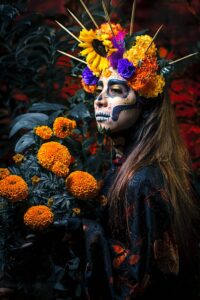 But in modern-day celebrations, people paint their faces to look like skulls, decorating them to represent a deceased loved one or an expression of themselves.
But in modern-day celebrations, people paint their faces to look like skulls, decorating them to represent a deceased loved one or an expression of themselves.
Flowers are used in costumes for the Day of the Dead. The flower crown is an essential element of the festivities. These crowns are often woven together using marigolds, white mum, and white baby’s breath. Red cockscomb may be added for an additional dash of bright color.
Dia De Los Muertos is a spiritually rich, happy holiday that reunites the living and dead. Families create offerings to honor their departed family members. These altars are decorated with bright yellow marigold flowers, photos of the departed, and the favorite foods and drinks of the one being honored.
The offerings are believed to encourage visits from the land of the dead as the departed souls hear their prayers, smell their foods, and join in the celebrations!
Whether it’s Halloween, All Saints’ Day, or Day of the Dead, the holidays celebrated during mid-autumn invite us to peek behind the veil of our physical world and connect with residents of the spirit world — especially our ancestors.
Festival of the Crone
It is said that the veil that separates the seen and unseen worlds is at its thinnest on Hallows and blends as one during this time. Although the door between worlds of the living and the spirits of our ancestors is open on all four quarter days (the Equinox’s and Solstices), it is open widest at Hallows. This is the night our loved ones return to visit, feast, and tell us what they see from their perspective.
Hallows is the festival of the Crone. We honor the aged mother and grandmother, the wise old one, our healer, our counselor, and our judge. She is an archetype of wisdom, knowing that without death, there can be no life and vice versa.
On this night, the Crone comes to strip the leaves from the trees, to quicken the decay of the flesh of the year so that it may feed the new life to come. We can also ask Her to remove the unwanted aspects of our personal year so that these might be transformed.
It is the perfect time to connect with the spirit of mystery and magic, when we may open ourselves to our intuitive power and call forth the inherited wisdom of our ancestors.
Some ways we honor those who have passed on are by placing pictures of our deceased family members or ancestors on our altars with abundant marigold flowers.
Marigold Connects us to our Ancestors.
I am a naturally curious woman. I often wondered about the significance of marigold flowers and their association with the Day of the Dead. 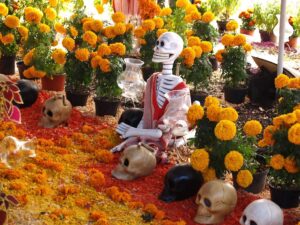
I’ve discovered that the marigold is considered a sacred flower for those who celebrate the Day of the Dead—also known by its traditional folklore name of ‘Flor de muerto’ or Flower of the Dead.
Marigolds, the Aztecs’ flower of the goddess Cihualcoatl-Quilaztli (snake woman), a mother and fertility goddess. She reminds us that with life comes death too.
The marigold is supposed to attract the dead back to Earth during the Dia de Los Muertos festivities. Marigold’s bright yellows and oranges are like the sun.
Marigolds’ pungent smell attracts our ancestors by illuminating the path between the visible and non-visible worlds, the living and the dead. Their presence adorns our altars and pathways so that our ancestors know they have a place in our homes.
A few days ago, I noticed that flower stands were selling big bouquets of marigolds. I stopped to buy some to decorate my altar for mi familia, my loved ones in my motherline who walked before me.
Calling your Ancestors Home
If you have been reading my blogs, you will know that I love rituals. The Samhain Ritual may be elaborate or as simple as you like. Invite your family and children to help you honor those who walked before. Allow your intuition to guide you by 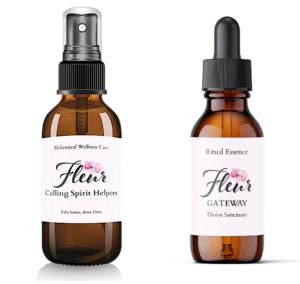
- Creating an altar decorated with photos of your family members who have passed on.
- Decorate it with candles, marigolds, a glass of water, and food offerings.
- Have on hand Gateway Ritual Essence and Calling Your Spirit Helpers Spray.
Write or Draw your Intention for your Ritual
An intention is a way to bring heart and mind into alignment. Written with the energy of the heart, it is a clear signal to the universe, your subconscious, and your conscious mind to call in the experiences and energy you wish to receive and give voice to during your ritual as you hold space for your departed ones to join you in celebration.
When you’re pleased with your ancestor altar,
- Light the candle.
- Mist Calling Your Spirit Helpers Spray around you.
- Place three drops of Gateway Ritual Essence on the top of your head, your forehead, and at your heart.
- Close your eyes and breathe deeply.
- Think about who you are: your strengths and your weaknesses.
- Meditate on the generations of people who have come together over the centuries to create the person you are now. This is a time to honor the ancestors who formed you.
- Know that everything within you is the sum of all your ancestors.
Recite Ancestor Prayer* aloud:
“Blessings to those who have gone before.
I call to my ancestors who lived and died before I took breath,
to all the mothers and fathers who created life,
who created life,
who created me.
Walk with me tonight.
I call to the ancestors who lived and died in my lifetime,
my beloved dead, my family, my friends.
Those who made me laugh and shared in my tears,
who shared this journey with me,
who shared their journey with me.
I call you home.
All of my ancestors,
all of our relations,
I wait to greet you.
Visit with me again.
My breath is your breath.
My bones are your bones.
We are all relations.
I drink water for you.
I take in food for you.
Together we light the beacon…
Together we stand in the doorway…
We call to the recently dead.
We offer your names to the air.
We offer your names in prayer.
Recite your Genealogy
- Aloud if you like and as far back as you can go.
- As you say each name, describe the person and their life.
- Retell their story, in your own words, to yourself and your guests, elaborating in as much detail as you choose
- Sit quietly and think of all the things that you wanted to tell them when they still lived here on Earth.
- Tell them how it is with you – what regrets you may have and what you feel empathy and compassion for.
- Sit quietly and feel their presence.
- Appreciate them for who they were, with no expectations or apologies, and know they are watching over you.
- Once you can go back no further, end with the statement acknowledging “those whose blood runs in me, whose names I do not yet know.”
- Finally, say goodbye to each person. Release each person from hurt, resentment, anger, sadness, or trauma.
- Remind them that they are free.
- Take a moment to thank them for sharing their wisdom.
- Let go of everything but the love.
- Give them permission to go on to new lives.
Safest passage to each of you.
You are remembered,
you are loved,
I call you home.
Be at peace.”
Quietly Reflect
- Quietly sit at your altar and contemplate the wholeness of your experience.
- Notice how you feel, what it’s like to be in your body now.
- Sit in the vibration of your aliveness and soak in whatever sensations are present for as long as feels right to you.
- Note any information your ancestors may have given you if you met a particular ancestor or their archetype.
- Please write it down. Even if it doesn’t make sense now, it may help later on when you give it some more thought.
Close your Ritual with Gratitude
Extinguish your candle, and say aloud, “With my eyes turned to the past, I walk backward into the future. It is done, it is done, it is done, Aho!”
The expression of gratitude is a powerful conduit for a life well lived. Gratitude for embodying a self and for those who came before, your ancestors. Gratitude for all the forces of love that weave your lives together and those who have joined you in your ritual.
Gratitude for the seasonal dark, the only constant that is change, and the ongoing process of alchemical transformation renews life inwardly and outwardly. Pause for a while to appreciate all of the gifts you’ve received,
All Hallows Blessings!
We are our ancestors. We are the culmination of all our lineage has ever been, all the knowledge gathered, the trials and errors, the explorations, the traumas, and the breakthroughs. All of this is contained in the blueprint of our being, and we reap the benefit of this cumulative effort.
We have the capacity while we are embodied to remedy things in our lineage that may be out of alignment and unresolved. A powerful way of affecting things beyond our realm of perception is by directing our attention through ceremony.
To remember who we are and who are ancestors are is to claim the sacredness of ourselves. To recognize that the sacred is the effortless flowing pulse of what is, knowing ourselves as best we can now and honoring the life lived now.
It is through our choices to let this awareness nourish and heal us. To have the possibility of being ‘awake’ in ever-increasing degrees and to direct our heart intent to pay it forward in our personal and collective evolution willingly.
Yet even on the darkest night of Samhain, while our minds ponder our mortality and our ancestors, if we listen carefully, we can hear the sound of a new life, for soon it will be the Winter solstice, and the Wheel will turn once more.
All my aromatic love,
Vidya
* Ancestor prayer modified from Sarah Lyn, 2014, Walking with Ancestors.

